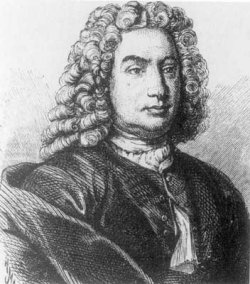
|
|
Young Scientist and Technology Exhibition 2001
The Bernoulli Principle
 Daniel Bernoulli was a Swiss physicist and mathematician who made important discoveries in hydrodynamics. Born into a family of mathematicians on February 8, 1700, he was the only member of his family to make a mark in physics. He was educated and received his doctorate in Basel, Switzerland.
Daniel Bernoulli was a Swiss physicist and mathematician who made important discoveries in hydrodynamics. Born into a family of mathematicians on February 8, 1700, he was the only member of his family to make a mark in physics. He was educated and received his doctorate in Basel, Switzerland.He discovered that fast moving air exerts less pressure than slow moving air. This principle makes airplanes and gliders fly. The wing is shaped so that the air going over the top of the wing moves faster than the air on the bottom of the wing. The air travels farther and faster over a curved surface than a straight surface. Because the air on the curved upper surface moves faster it flows at lower pressure than the slow moving air on the bottom flat surface. The higher pressure from below the wing then pushes it upwards. This makes the wing rise and keeps the plane in the air.
In order to show Bernoulli's Perinciple in action, we did three simple experiments.
(1) Make your own wing:
Equipment: strip of card, straw, sellotape, thread, hair dryer
Method: (a) To make a wing, get a piece of light card and fold to make a wing shape and stick it down with sticky tape.(b) Then punch a hole in the middle of the card with a pencil and stick a straw in.
(c) Put a piece of thread or string down the straw and hold it at the two ends.
Result: Blow over the curve with a hair dryer and the wing should rise up the string. The air is forced to travel faster over the curved surface creating low pressure. The higher pressure under the wing forces it into the air. This demonstrates lift.
(2) Float a table tennis ball on a cushion of air!
Equipment: straw, table tennis ball, hair dryer (optional)Method: Blow through the straw and place the table tennis ball directly above. The ball sits on a cushion of air.
The air pressure hits the ball and the ball blocks it. Therefore, low pressure (faster moving air) moves around the sides of the ball, leaving higher pressure underneath.Result: The ball hovers above the straw. Indeed, as the photo below shows, a hair dryer is even more effective!
(3) "The Bernoulli Principle".
Equipment: Thread, two table tennis balls, straw, wooden frame (optional)Method: Sellotape the table tennis balls to thread and suspend them from the frame (or other suitable object) on thread. Blow very hard through the straw between the balls and observe what happens.Result: The balls should slam against each other because you are creating low pressure by blowing through the straw. The high pressure pushes the balls together.
(4) Create a stream of air at low pressure over a strip of paper.
Equipment: A strip of paper!Method: You put a strip of paper under your lip.
Blow over the top of the paper.Result: When you blow over the top, low pressure flows across the top. The high pressure pushes the paper up.
The Bernoulli Effect | Leonardo da Vinci | Kites | The first Balloon Flight
| Lindbergh and Earhart
| The Wright Brothers | The Future





